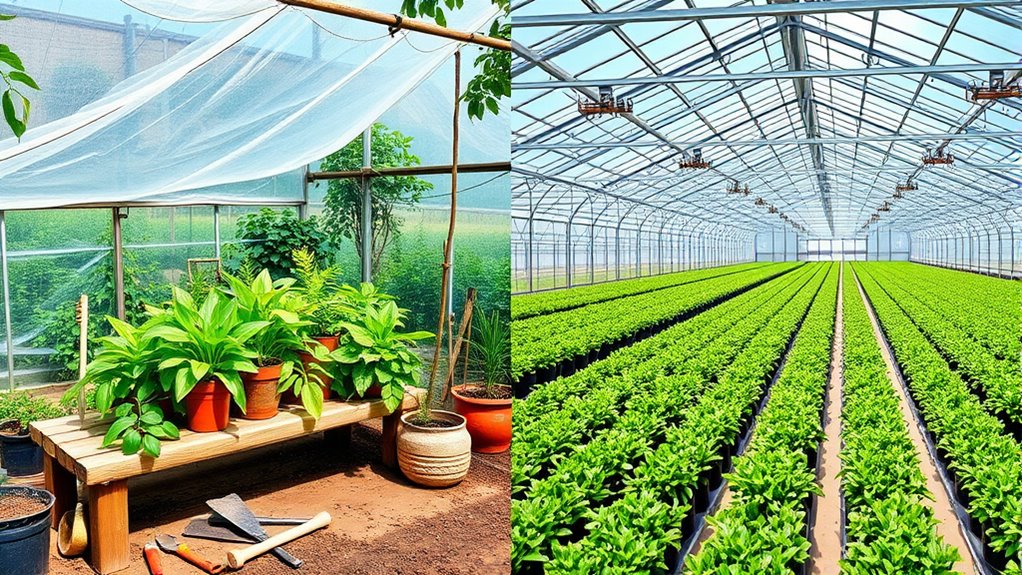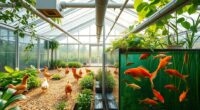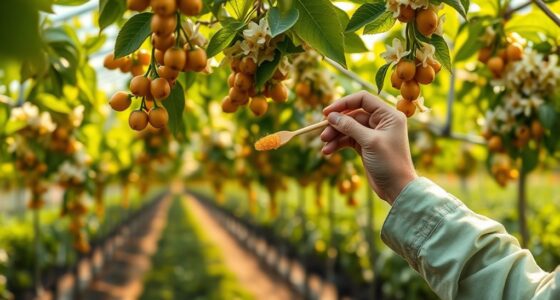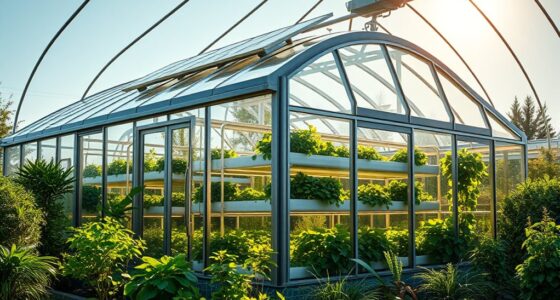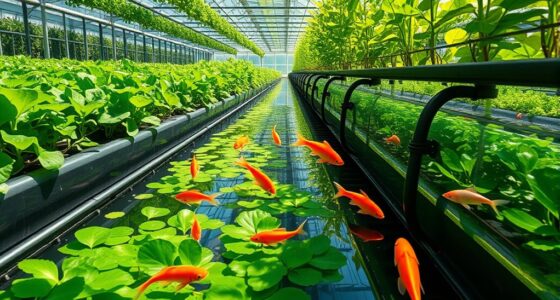If you’re managing a small-scale greenhouse, focus on sustainable practices like crop rotation, companion planting, and organic pest control to keep costs low and maintain soil health. For larger operations, leverage advanced systems like integrated pest management, automation, and data-driven strategies to optimize pest control and maximize yields efficiently. Adjust your approach based on size, and you’ll discover how tailored methods can boost productivity and sustainability—more insights await as you explore further.
Key Takeaways
- Small-scale greenhouses prioritize low-cost, sustainable practices like crop rotation, companion planting, and organic pest control, while commercial ones use advanced systems.
- Commercial greenhouses employ technology such as sensors, automation, and integrated pest management for precise control and monitoring.
- Crop rotation in small-scale setups is simple and focuses on disrupting pests, whereas commercial rotations are planned to maximize profitability and yield.
- Pest management at small scale relies on natural methods and early detection, while large-scale operations integrate biological controls and targeted chemical use.
- Resource efficiency is essential in small-scale greenhouses, while commercial strategies emphasize systematic planning, market demand, and data-driven decisions.
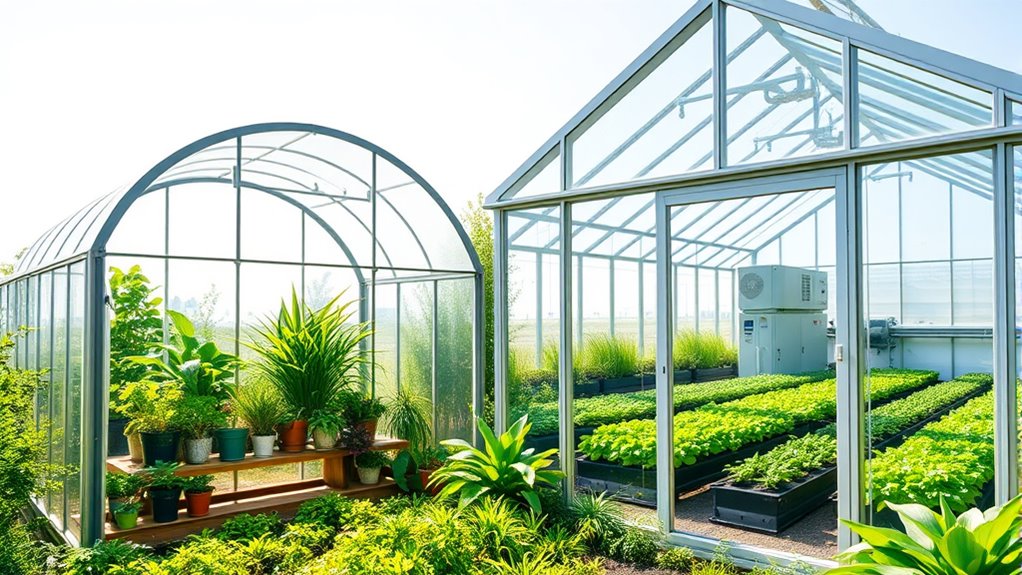
Creating an effective greenhouse strategy is fundamental for maximizing your crop yields and guaranteeing healthy plant growth year-round. Whether you’re managing a small-scale setup or a large commercial operation, your approach needs to be tailored to your space and goals. For small-scale growers, focusing on crop rotation and pest management is essential to maintain soil health and prevent disease buildup. Since space is limited, you have to be strategic about rotating different plant families to disrupt pest life cycles and avoid soil fatigue. Switching crops regularly also helps in managing pests naturally, reducing the need for chemical interventions. For instance, after harvesting leafy greens, you might rotate in root vegetables or herbs, which can break pest cycles specific to a particular crop. This rotation minimizes pest infestations and keeps your plants healthier, leading to better yields over time.
Crop rotation and pest management are key to healthy, high-yielding small-scale greenhouses.
In a small greenhouse, you often work with a limited number of tools and resources, so implementing pest management techniques that are sustainable and low-cost becomes indispensable. Companion planting, biological controls, and organic sprays can be highly effective when carefully timed and integrated into your crop rotation schedule. These methods help keep pest populations in check without overwhelming your space or budget. Additionally, maintaining cleanliness and monitoring plants closely allows you to catch problems early, reducing the risk of widespread infestations.
When it comes to larger, commercial greenhouses, your strategy needs to be more sophisticated. Here, you can employ advanced pest management systems like integrated pest management (IPM), which combines biological controls, targeted chemical applications, and environmental modifications. Crop rotation remains important, but it often involves more complex planning to optimize space and maximize profitability. You’re likely to incorporate crop schedules that align with market demand, and rotation can help prevent disease and pest buildup across extensive planting beds. You might also use sensors and automation to monitor pest activity and soil health continuously, allowing for more precise interventions.
Furthermore, adopting data-driven marketing strategies can significantly improve your greenhouse’s market reach and profitability. Regardless of the size of your greenhouse, a proactive approach to crop rotation and pest management is essential. Small-scale growers must prioritize sustainable, low-input methods that maximize space and resource efficiency. Meanwhile, larger operations should leverage technology and systematic planning to control pests and maintain soil vitality. In both cases, staying vigilant and adapting your strategies as your operation evolves guarantees healthy plants, high yields, and long-term success.
Frequently Asked Questions
How Do Climate Control Systems Differ Between Small and Large Greenhouses?
Climate control systems differ mainly in ventilation requirements and humidity control. In small greenhouses, you can rely on simpler, cost-effective solutions like exhaust fans and shade cloths to manage airflow and humidity. Larger greenhouses need more advanced systems, such as automated ventilation, dehumidifiers, and climate sensors, to maintain consistent conditions. Your goal is to optimize airflow and humidity levels tailored to your greenhouse size for healthy plant growth.
What Are the Cost Considerations for Scaling Greenhouse Operations?
When scaling your greenhouse operation, you need to take into account costs carefully. Financial planning helps you allocate funds for equipment, supplies, and infrastructure. Labor costs tend to rise with size, so you should plan for hiring or training staff. Larger greenhouses may require more advanced systems, increasing initial investment. By analyzing these factors, you can make informed decisions to guarantee your expansion is sustainable and profitable.
How Does Crop Selection Vary With Greenhouse Size?
In your greenhouse, crop selection depends on your space and goals. For larger setups, you can diversify crops and increase planting density, maximizing yields and market appeal. Smaller greenhouses might focus on fewer, high-value plants to optimize limited space. By adjusting crop diversity and planting density, you tailor your approach to your greenhouse size, ensuring efficient use of resources and meeting your production targets effectively.
What Are the Best Pest Management Practices for Different Greenhouse Sizes?
Pest management is your greenhouse’s shield, whether it’s a cozy nook or a bustling empire. You’ll want a tailored approach—integrated pest management blends cultural, physical, and biological controls like biological control agents to keep pests at bay. Smaller greenhouses may rely more on manual removal and targeted treatments, while larger operations benefit from proactive monitoring and natural predators. Stay vigilant, adapt your strategies, and let biological control be your trusted guardian.
How Can Technology Optimize Efficiency in Small Versus Commercial Greenhouses?
Technology can substantially boost efficiency by implementing automated irrigation systems that adjust water delivery based on real-time data, reducing waste and labor. Data analytics help you monitor plant health, optimize resource use, and predict maintenance needs, whether you’re managing a small or large greenhouse. These tools streamline operations, improve yields, and save costs, making your greenhouse more sustainable and productive regardless of its size.
Conclusion
Whether you’re managing a small-scale or large commercial greenhouse, tailoring your strategies is key. Small growers often benefit from personalized care, while large operations rely on automation and efficiency. Remarkably, studies show that small greenhouses can yield up to 40% higher profit margins per square foot due to lower overhead costs. By understanding your greenhouse size, you can implement the most effective techniques and maximize your productivity and profitability.
